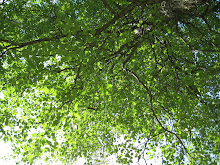Josh Corey on miellyttävän asiallisessa ja pohdiskelevassa blogissaan osallistunut joulukuussa keskusteluun runon orgaanisuudesta ja epäorgaanisuudesta, elollisuudesta ja ei-elollisuudesta, ja tämä alunperin Peter Bürgerin Theory of the Avantgarde -teoksessa esitelty dikotomia tuntuukin käyttökelpoiselta käsiteparilta nykyrunouden analysoimiseen:
"(...) Or maybe we should look to another general dichotomy, Bürger's notion of the "organic" versus the "nonorganic" artwork. While avant-garde movements are characterized by wanting to reintegrate art into life, their works, according to Bürger, are formally recognizable by their use of fragmentation and montage. Organic or symbolist works are recognizable by the unity of the parts with the whole: each part is subordinated to that wholeness and is only comprehensible through/in it. The notion of art being a mirror to nature is one of the premises of organic art, which might also be the source of the "aura" Benjamin locates in artworks prior to our age of mechanical reproduction. By contrast, in the nonorganic artwork the parts do not form a unity: it is an assemblage of pieces between which cracks are visible, and the pieces have some degree of independence from the unity of the total work. The more minimal (or the less intrusive) the structure of the whole is, the more independence the parts have, and the "harder" the poem is likely to be—the Andrews poem Chris quotes is a good example of this. But they never achieve total independence, or fall into chaos; (...)"
Corey jatkaa aiheesta myös eilisessä postissaan, liittyen tällä kertaa kuitenkin Joan Houlihanin kolumnin kommentoimiseen - keskustelu joka liittyy runon vaikeuteen, jota myös meillä vaikkapa Kiiltomadon keskusteluissa silloin tällöin sivutaan.
"(...) because the pleasures of the nonorganic as practiced in North America since WWII require an education that most people don't bother to seek out. It's an acquired taste and the cultural education that not only constitutes the taste but encourages you to acquire it (no one likes their first sip of beer but there are any number of cultural markers and pressures that persuade us to keep trying it until we do) has been privatized. That is, there is scarcely any form of public education any longer—even at the university level—that makes it possible for the average intelligent person to access the necessary range of reference (the context, the framework) to read even an organic poem with pleasure now. We get a massive and profuse education in "reading" other media like movies (and to a much lesser degree, nowadays, novels) from birth in this culture: nobody you bring into a movie theater will have trouble choosing a good seat, much less be unable to realize that they're supposed to face the screen and turn the images their into representations of human beings like themselves. But that's the level of illiteracy most people bring to poetry now, because poetry on the page (spoken poetry is alive and well in rap and advertising) is no longer taught in any meaningful public way. (...)"
Runon vaikeudesta puhuttaessa on Suomessa viime vuosina rajanvedot usein tehty yksinkertaistavilla käsitteillä "akateeminen" tai "postmoderni" tai "teoria" -runo vs. ymmärrettävä, lukijaa puhutteleva runo... Ja ehkäpä 90-luvun dikotomia "turkulainen" vs. "helsinkiläinen" runous kantoivat myös mukanaan oletusta turkulaisen runouden helppoudesta - koska se kumpuaa suoraan ja välittömästi kokemuksesta - vai voisiko sanoa: koska se jäljittelee suoran puheen ja kokemuksen välittömyyden retoriikkaa - vs. helsinkiläisen runouden vaikeus, jonka syynä taas oli liika "ranskalaisen filosofian" läsnäolo runoissa. (Väitteitä on sittemmin kumottu ja molempien kaupunkien runouden monimuotoisuus paremmin huomioitu. Tarkemmat analyysit odottavat vielä kirjoittajaansa. Mistä johtui esim. minän ja kokemuksellisuuden esiinnostaminen, "katu-uskottavuuden" korostuminen "turkulaisessa" runoudessa? Mitkä olivat runon keinot tällaisen vaikutuksen synnyttämiseen? Millainen oli Nuoren Voiman ja "helsinkiläisten" runojen suhde, näkyvätkö "teoriat" runoissa, ja jos niin miten?)
Ärtymys "vaikeiden" runojen edessä ja syiden etsintä siitä, että runo on liian akateeminen tai teoriapainotteinen, tuntuvat keppihevoskeinoilta siirtää pettymys ja turhautuminen runon niskaan. Pitäisi huomata se, että runouden kuten muidenkin medioitten ja kirjallisuuden lajien lukeminen vaatii aina opintoja - ennakkokäsityksiä siitä, miten kunkin tekstityypin kanssa toimitaan; millaisesta totuudellisuudesta tai sen asteesta esim. on kyse.
Loppukevennyksenä voisin laittaa linkin vielä Charles Bernsteinin esseeseen The Difficult Poem.
Subscribe to:
Post Comments (Atom)

No comments:
Post a Comment